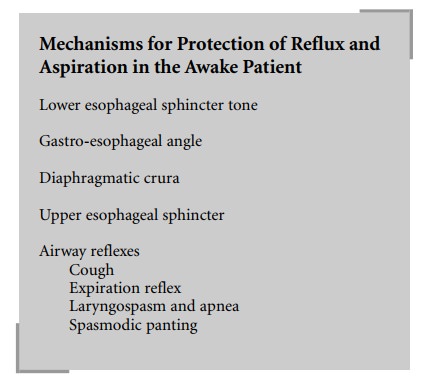Chapter: Clinical Cases in Anesthesia : Full Stomach
What are the mechanisms a conscious patient has to prevent regurgitation and pulmonary aspiration?
What are
the mechanisms a conscious patient has to prevent regurgitation and pulmonary
aspiration?
The lower esophageal sphincter (LES) is the primary barrier to
gastro-esophageal reflux. The LES is 2–5 cm long, and moves upward with
inspiration and downward with expiration. Upon swallowing, the esophagus under-goes
peristaltic contractions to allow the passage of food and the LES relaxes. This
sphincter traverses the diaphragm and has a resting pressure greater than
gastric pressure. The difference in these pressures (LES pressure minus gastric
pressure) is known as “barrier pressure.” In normal sub-jects, an increase in
abdominal pressure will trigger an increase in LES pressure, thus maintaining
barrier pres-sure. Reflux occurs when the barrier pressure decreases, either
when the LES pressure decreases or the gastric pres-sure increases.

The angle at which the esophagus meets the stomach also protects against reflux. If the angle is oblique, high gastric pressures are required to cause reflux. If, however, the angle is small (as often occurs in patients with morbid obesity or a gravid uterus), reflux may occur at lower gastric pressures.
The upper esophageal sphincter is another
mechanism to protect against regurgitation. Virtually all commonly used general
anesthetics including muscle relaxants cause relaxation of this sphincter.
Another protective mechanism is the
diaphragmatic crura that tighten the lower esophagus to prevent reflux.
Finally, there are intrinsic airway reflexes
used to protect the airway against aspiration in the event of regurgitation.
These include coughing (a period of brief inspiration followed by a forceful
expiration), the expiration reflex (expiration without inspiration),
laryngospasm and apnea (with closure of both the false cords and the true
cords) and spasmodic panting (rapid shallow breathing).
Related Topics